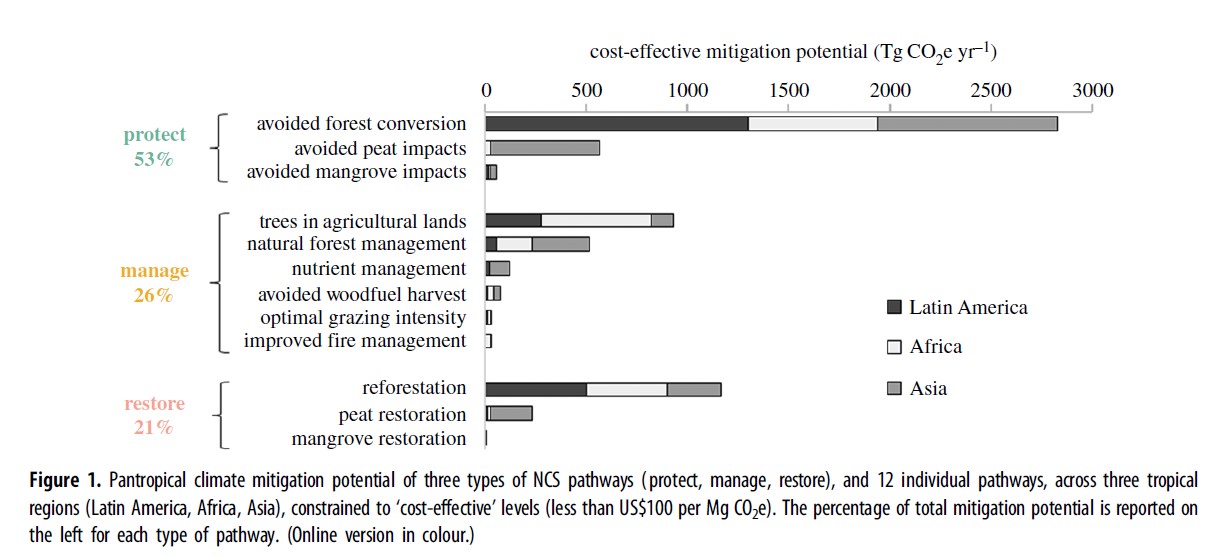
Misrepresents a complex reality: The effects of tree plantings as a climate solution vary depending on tree species, tree age, geographic location, and how efforts are implemented.

REVIEW
CLAIM: “Trees provide a solution to almost all environmental crises we're facing. Trees reverse climate change by cleaning carbon from the air.”
REVIEW
Initiatives to plant trees as a climate solution have sprouted up around the world over the past few years. One of these initiatives, 8 Billion Trees, recently published a video on Facebook featuring Pamela Anderson claiming that “trees provide a solution to almost all environmental crises we’re facing.” While planting trees can help mitigate some ongoing environmental crises, reducing fossil fuel emissions and avoiding deforestation are the most important climate solutions, as described by the reviewers below[1-4].
For example, an assessment of natural climate solutions strategies in Latin America, Africa, and Asia found that protecting forests, peatlands, and mangroves provided twice the climate mitigation potential as reforestation efforts (see figure below).
From Griscom et al. (2020)[3].
The video also claims that “trees reverse climate change by cleaning carbon from the air.” Trees remove carbon from the air as they grow and can store carbon for long periods of time, however they only absorb a fraction of the carbon emitted by humans each year[5], and as such, it is incorrect to say that this approach can “reverse” climate change.
“Global fossil fuel emissions totaled about 9.5 Gt C per year from 2009-2018, while Earth’s land ecosystems (i.e., forests, grasslands) sequestered about 3.2 Gt C per year from the atmosphere[6],” said Logan Berner, Assistant Research Professor at Northern Arizona University. “Thus, burning fossil fuels emitted about three times as much carbon each year as was taken up by all of Earth’s land ecosystems!”
In addition, the amount of carbon sequestered by forests saturates over time and varies depending on tree species, tree age, and geographic location, as well as numerous other factors[2,4,7,8].
Although trees provide a variety of ecosystem services by stabilizing soil, preventing flooding, and creating and connecting habitat for a broad range of species[2,4], they can only mitigate some effects of climate change, not “reverse” or address “all environmental crises”, as claimed in the video. Tree plantings can also fail to deliver their intended climate benefits if efforts are not effectively designed, implemented, or monitored properly over time, as the reviewers describe below.
SCIENTISTS’ FEEDBACK
Erle Ellis, Professor, University of Maryland, Baltimore County:
[Comment from a previous evaluation of a similar claim]
Tree growth can only slow down carbon accumulation in the atmosphere, not stop it. Ultimately, the only solution to climate change is to stop burning fossil fuels, which in turn requires a transition to inexpensive clean energy.
Karen Holl, Professor, University of California, Santa Cruz:
[Comment from a previous evaluation of a similar claim]
As Dr. Brancalion and I discuss in our brief article and a subsequent article that is currently in review, increasing tree cover is part of the solution to climate change but it is just one piece of the puzzle[4]. The most important steps are first reducing greenhouse gas emissions and second protecting existing forests and other high carbon storage ecosystems (e.g. wetlands). A few key points here:
First, planting trees is not going to solve the problem of climate change if we don’t reduce greenhouse gas emissions. As temperatures rise and precipitation patterns change, large areas are becoming unsuitable habitat for trees due to direct water stress and indirectly through fires and insect outbreaks. Moreover, some existing forests are slowing in their capacity to uptake carbon[7].
Second, it is important to protect existing forests first. Existing forests, rain forests in particular, store large amounts of carbon both above- and below-ground. As a restoration ecologist who has spent over 25 years studying how to restore forests, I know that it is nearly impossible to restore exactly what was there before, and it makes much more ecological and economic sense to protect existing forests so that should be the priority. Yet, large scale forest clearing continues worldwide. For example, in the U.S. the Trump administration is proposing to allow logging in the Tongass National Forest, at the same time that they have expressed support for the Trillion Trees Act. Temperate rain forests store huge amounts of carbon. Likewise, in Brazil there are extensive efforts to restore the Atlantic forest ecosystem in southeastern Brazil at the same time that deforestation and forest fires have increased substantially in the past couple of years. Efforts should focus on reducing the drivers of deforestation and enforcing existing legislation that protects forest.
Third, it is important to distinguish between tree planting and increasing tree cover or forest cover. Many forests are able to recover on their own if degrading factors are removed, so often it is not necessary to plant trees[9]. Allowing for natural recovery should be the first option for restoring forests, as it is more ecologically and economically sound. If it is necessary to plant trees either due to slow recovery or for socioeconomic reasons then the focus should be on restoring tree cover over the long-term. Many of these large-scale planting schemes focus on the number of trees put in the ground without considering who is going to care for and monitor the trees and whether the social conditions are in place for the trees to not be cleared. This has led to many massive tree planting failures. It also means that the cost of planting trees is substantially underestimated. The cost needs to include not only growing the seedling, digging the hole and planting the tree, but management such as clearing competitive vegetation and monitoring the outcomes of tree planting over the longer term.
William Anderegg, Associate Professor, University of Utah:
[Comment from a previous evaluation of a similar claim]
The carbon sequestered in existing forests is far, far larger than planted trees, which further emphasizes that stopping deforestation should probably be a much higher priority than planting new forests. In addition, it will take decades for planted trees to store substantial amounts of carbon, which means that tree planting solutions are not a fast climate solution. By contrast, any effort that reduces fossil fuel or deforestation emissions are immediate climate solutions that benefit the atmosphere today and in the future.
READ MORE
Climate Feedback published an insight article exploring the potentials and limitations of tree planting as a climate solution.
REFERENCES
- 1 – Lewis et al. (2019) Comment on “The global tree restoration potential.” Science.
- 2 – Griscom et al. (2017) Natural climate solutions. PNAS.
- 3 – Griscom et al. (2020) National mitigation potential from natural climate solutions in the tropics. Phil. Trans. R. Soc. B.
- 4 – Holl et al. (2020) Tree planting is not a simple solution. Science.
- 5 – Korner (2017) A matter of tree longevity. Science.
- 6 – Friedlingstein et al. (2019) Global carbon budget 2019. Earth System Science Data.
- 7 – Nabuurs et al. (2013) First signs of carbon sink saturation in European forest biomass. Nature Climate Change.
- 8 – Fuss et al. (2018) Negative emissions—Part 2: Costs, potentials and side-effects. Environmental Research Letters.
- 9 – Chazdon et al. (2019) Restoring forests as a means to many ends. Science.



